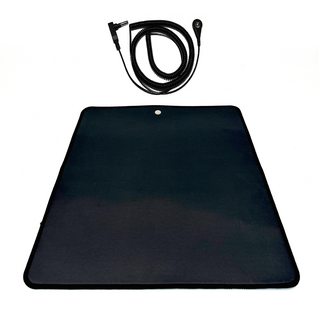Anti Fatigue Earthing Seat Mat
The anti-fatigue seat mat provides a convenient way to connect to the Earth's electrical field while you are indoors. For additional information about this handy earthing mat, visit our blog, "Indoor Earthing". The more time you spend grounded, the better. To use the mat, attach the 15' cord to the mat and plug it into a grounded wall outlet. You can utilize this earthing mat in multiple positions, including sitting, standing, or sleeping. The mat is shaped like a seat with one slightly wider side and measures approximately 13" x 13". The thin black top conductive layer comprises PU (Polyurethane) resin. It is vinyl-free and phthalate-free. The thin black layer of PU leather is infused with conductive carbon pigment for the conductive top layer. Carbon is the 2nd most abundant element in the human body after oxygen and is what conducts the Earth's energy. The bottom, or non-conductive layer, comprises TPE (Thermoplastic Elastomer) closed-cell foam (latex and PVC free). Bare skin is best for contact with the mat, but a natural material such as cotton can allow earthing. Cleaning is easy—wipe with a damp cloth or mild soap and warm water.
If you're concerned about cords or having enough grounded outlets, consider adding a splitter or grounding extension box to keep cords tidy and in one spot.
The anti-fatigue seat mat provides a convenient way to connect to the Earth's electrical field while you are indoors. For additional information about this handy earthing mat, visit our blog, "Indoor Earthing". The more time you spend grounded, the better. To use the mat, attach the 15' cord to the mat and plug it into a grounded wall outlet. You can utilize this earthing mat in multiple positions, including sitting, standing, or sleeping. The mat is shaped like a seat with one slightly wider side and measures approximately 13" x 13". The thin black top conductive layer comprises PU (Polyurethane) resin. It is vinyl-free and phthalate-free. The thin black layer of PU leather is infused with conductive carbon pigment for the conductive top layer. Carbon is the 2nd most abundant element in the human body after oxygen and is what conducts the Earth's energy. The bottom, or non-conductive layer, comprises TPE (Thermoplastic Elastomer) closed-cell foam (latex and PVC free). Bare skin is best for contact with the mat, but a natural material such as cotton can allow earthing. Cleaning is easy—wipe with a damp cloth or mild soap and warm water.
If you're concerned about cords or having enough grounded outlets, consider adding a splitter or grounding extension box to keep cords tidy and in one spot.
Reviews






